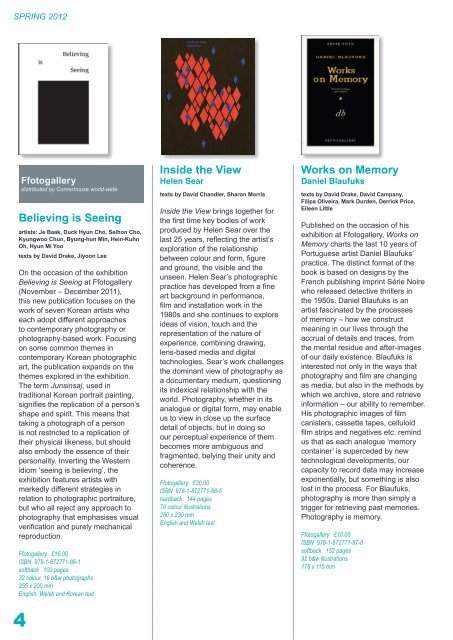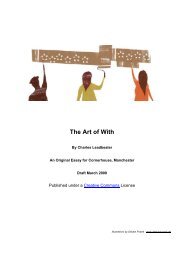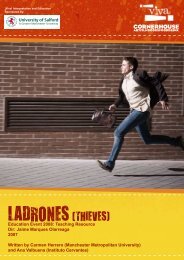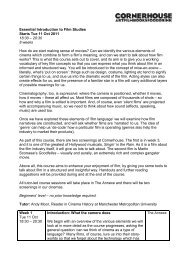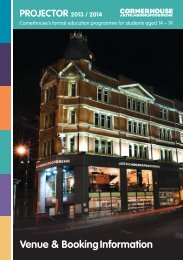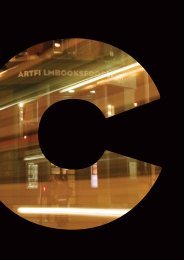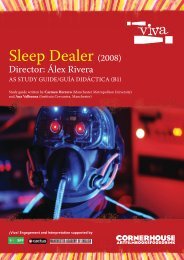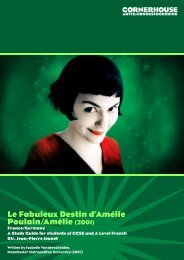PDF catalog - Cornerhouse
PDF catalog - Cornerhouse
PDF catalog - Cornerhouse
Create successful ePaper yourself
Turn your PDF publications into a flip-book with our unique Google optimized e-Paper software.
SPRING 2012<br />
Ffotogallery<br />
distributed by <strong>Cornerhouse</strong> world-wide<br />
Believing is Seeing<br />
artists: Je Baak, Duck Hyun Cho, Seihon Cho,<br />
Kyungwoo Chun, Byung-hun Min, Hein-Kuhn<br />
Oh, Hyun Mi Yoo<br />
texts by David Drake, Jiyoon Lee<br />
On the occasion of the exhibition<br />
Believing is Seeing at Ffotogallery<br />
(November – December 2011),<br />
this new publication focuses on the<br />
work of seven Korean artists who<br />
each adopt different approaches<br />
to contemporary photography or<br />
photography-based work. Focusing<br />
on some common themes in<br />
contemporary Korean photographic<br />
art, the publication expands on the<br />
themes explored in the exhibition.<br />
The term Junsinsaj, used in<br />
traditional Korean portrait painting,<br />
signifies the replication of a person’s<br />
shape and spirit. This means that<br />
taking a photograph of a person<br />
is not restricted to a replication of<br />
their physical likeness, but should<br />
also embody the essence of their<br />
personality. Inverting the Western<br />
idiom ‘seeing is believing’, the<br />
exhibition features artists with<br />
markedly different strategies in<br />
relation to photographic portraiture,<br />
but who all reject any approach to<br />
photography that emphasises visual<br />
verification and purely mechanical<br />
reproduction.<br />
Ffotogallery £15.00<br />
ISBN 978-1-872771-86-1<br />
softback 100 pages<br />
32 colour, 16 b&w photographs<br />
255 x 200 mm<br />
English, Welsh and Korean text<br />
Inside the View<br />
Helen Sear<br />
texts by David Chandler, Sharon Morris<br />
Inside the View brings together for<br />
the first time key bodies of work<br />
produced by Helen Sear over the<br />
last 25 years, reflecting the artist’s<br />
exploration of the relationship<br />
between colour and form, figure<br />
and ground, the visible and the<br />
unseen. Helen Sear’s photographic<br />
practice has developed from a fine<br />
art background in performance,<br />
film and installation work in the<br />
1980s and she continues to explore<br />
ideas of vision, touch and the<br />
representation of the nature of<br />
experience, combining drawing,<br />
lens-based media and digital<br />
technologies. Sear’s work challenges<br />
the dominant view of photography as<br />
a documentary medium, questioning<br />
its indexical relationship with the<br />
world. Photography, whether in its<br />
analogue or digital form, may enable<br />
us to view in close up the surface<br />
detail of objects, but in doing so<br />
our perceptual experience of them<br />
becomes more ambiguous and<br />
fragmented, belying their unity and<br />
coherence.<br />
Ffotogallery £30.00<br />
ISBN 978-1-872771-88-5<br />
hardback 144 pages<br />
70 colour illustrations<br />
280 x 230 mm<br />
English and Welsh text<br />
Works on Memory<br />
Daniel Blaufuks<br />
texts by David Drake, David Campany,<br />
Filipa Oliveira, Mark Durden, Derrick Price,<br />
Eileen Little<br />
Published on the occasion of his<br />
exhibition at Ffotogallery, Works on<br />
Memory charts the last 10 years of<br />
Portuguese artist Daniel Blaufuks’<br />
practice. The distinct format of the<br />
book is based on designs by the<br />
French publishing imprint Série Noire<br />
who released detective thrillers in<br />
the 1950s. Daniel Blaufuks is an<br />
artist fascinated by the processes<br />
of memory – how we construct<br />
meaning in our lives through the<br />
accrual of details and traces, from<br />
the mental residue and after-images<br />
of our daily existence. Blaufuks is<br />
interested not only in the ways that<br />
photography and film are changing<br />
as media, but also in the methods by<br />
which we archive, store and retrieve<br />
information – our ability to remember.<br />
His photographic images of film<br />
canisters, cassette tapes, celluloid<br />
film strips and negatives etc. remind<br />
us that as each analogue ‘memory<br />
container’ is superceded by new<br />
technological developments, our<br />
capacity to record data may increase<br />
exponentially, but something is also<br />
lost in the process. For Blaufuks,<br />
photography is more than simply a<br />
trigger for retrieving past memories.<br />
Photography is memory.<br />
Ffotogallery £10.00<br />
ISBN 978-1-872771-87-8<br />
softback 152 pages<br />
92 b&w illustrations<br />
178 x 115 mm<br />
firstsite<br />
distributed by <strong>Cornerhouse</strong> world-wide<br />
Culpable Earth<br />
Steven Claydon<br />
texts by Martin Clark, Steven Claydon,<br />
Michelle Cotton, Patrizia Dander<br />
edited by Michelle Cotton<br />
Culpable Earth is a monographic<br />
publication about British artist Steven<br />
Claydon’s work, published by firstsite<br />
on the occasion of Claydon’s solo<br />
exhibition of the same name. This<br />
book features over 300 illustrations<br />
and previously unpublished texts<br />
about and by the artist, alongside an<br />
extended interview between Claydon<br />
and Martin Clark, Artistic Director,<br />
Tate St Ives.<br />
firstsite £19.95<br />
ISBN 978-0-948252-33-4<br />
softback 144 pages<br />
260 colour, 45 b&w illustrations<br />
242 x 212 mm<br />
GlobalArtAffairs<br />
Publishing<br />
distributed by <strong>Cornerhouse</strong> world-wide<br />
Hans Kotter<br />
Light Flow<br />
texts by Annett Zinsmeister, Kai-Uwe Hemken<br />
Colour and light are the main<br />
themes in Hans Kotter’s work,<br />
which comprises photography, light<br />
objects, and installations. It is the<br />
playful treatment of a wide range of<br />
materials such as oil, water, acrylic<br />
glass, stainless steel, chrome etc.<br />
and their effects in relation to light<br />
and colour which fascinates the<br />
artist and inspires him to try out new<br />
forms of expression continually. The<br />
abstraction of colour and light creates<br />
diffuse landscapes, the illusion of<br />
distance, mysterious waves, the<br />
impression of water, shimmering heat<br />
or the finest of fabrics, which seem<br />
to glide across the picture surface<br />
in undulating folds. The apparent<br />
materiality of Kotter’s unmanipulated<br />
photographs of the immaterial – of<br />
light and colour – points to their<br />
origins in painting, yet at the same<br />
time they document physical<br />
processes. The incredible degree<br />
of beauty, opulence, brilliance and<br />
simultaneous mystery with which<br />
natural scientific insights can be<br />
manifest in art is quite remarkable.<br />
Included is an interview with Hans<br />
Kotter.<br />
GlobalArtAffairs Publishing £20.00<br />
ISBN 978-3-941763-10-4<br />
softback 120 pages<br />
85 colour illustrations<br />
260 x 210 mm<br />
Haunch of Venison<br />
distributed by <strong>Cornerhouse</strong> world-wide<br />
Ahmed Alsoudani<br />
text by Suzannah Biernoff<br />
This <strong>catalog</strong>ue features works from<br />
the first solo show in Britain by<br />
acclaimed Iraqi-born artist Ahmed<br />
Alsoudani. In this new series of<br />
paintings, Alsoudani continues<br />
his complex exploration of war<br />
and conflict, its physical atrocities<br />
and psychological consequences.<br />
Featuring deformed, almost bestial,<br />
figures twisting in vivid and surreal<br />
landscapes, these tableaux are<br />
often laced with a barbed or morbid<br />
humour in the manner of artists<br />
such as Francisco Goya and Max<br />
Beckmann among others. Imagery of<br />
devastation and violence abounds,<br />
with figures depicted at the moment<br />
of a dramatic transition – through<br />
fear or agony – from the human<br />
to the grotesque. While Alsoudani<br />
acknowledges the influence of many<br />
artists on his work – from Caravaggio<br />
to Carroll Dunham – he has at the<br />
same time developed his own unique<br />
pictorial language, one based on his<br />
personal experiences of growing up<br />
in Baghdad under Saddam Hussein’s<br />
regime during the first Gulf War<br />
and of the more recent Iraq conflict.<br />
Published on the occasion of the<br />
exhibition at Haunch of Venison,<br />
London, 14 October – 26 November<br />
2011.<br />
Haunch of Venison £20.00<br />
ISBN 978-1-905620-59-3<br />
softback 62 pages<br />
illustrated in colour<br />
310 x 240 mm<br />
4<br />
5


